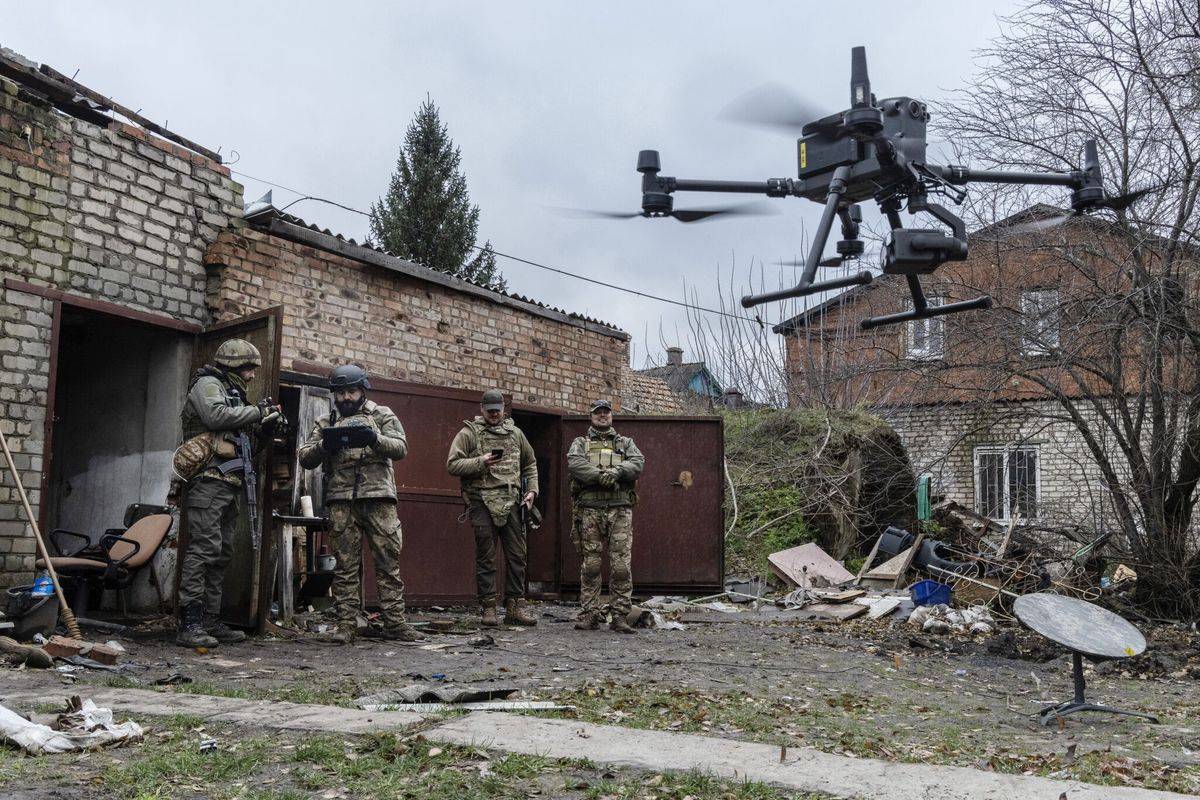SUBSCRIBER+EXCLUSIVE BRIEFING — It's difficult to clearly understand the real nature of the national security threat that exists at the U.S. southern border, namely because it's just too enticing of an issue for politicians to spin one way or another, leaving out critical context to put the threat into much-needed perspective.
For example, government data tells us that there has been a recent increase in the number of migrants who are on the U.S. terror watch list, or affiliated with someone who is - who have been arrested while trying to cross the border. But it is also true that within a one-year period, that number increased from 98 to 169 arrests while the total number of migrants believed to have crossed during that same timeframe is estimated at more than two million. Further complicating a clear picture of the threat, those arrested, according to the Department of Homeland Security's 2024 Homeland Threat Assessment, could include 'known associates' of those on the terror watch list, including family members. Statistically speaking, there are likely many other national security threats that pose a more significant risk to Americans. But that of course, doesn't mean that we don't have a serious problem at the U.S. southern border.
"We can't just allow anyone to come into our country, but they still come and we just don't have the number of border agents, we don't have proper barriers where we need them, we don't have enough sensor technologies, we don't have enough surveillance technologies to stop the flow," Representative Eric Swalwell (D-CA), who served on the House Subcommittee on Immigration, Integrity, Security and Enforcement told The Cipher Brief during a recent briefing on the issue of the national security risks at the U.S.' southern border. "And then for folks who present asylum cases, we don't have judges who can adjudicate those cases fast enough. And so you have folks in our country for many years without their cases being resolved. To solve something like that, you can't see the border as an opportunity to weaponize the crisis or politicize the crisis. You really have to try and solve it, and I believe you need all of that (security) and you need a earned pathway of citizenship, where no one would cut the line, but they would go through vetting and background and the process to become a citizen. And the priority should be to fill the jobs that Americans will not work. Having an immigrant workforce would bring down the costs, in childcare or hospitality. And so I hope we can achieve that in some way. And then of course, address the risk that comes with that flow - it's not just a mom and her kids fleeing a hardship that come here. It could be a terrorist affiliated with an ISIS cell or an Al-Qaeda cell in the Middle East."
The CIA was first tasked to assist with the flow of narcotics trafficking across the U.S. southern border in the 1980s and according to former senior CIA Officer David Fitzgerald, "One of the things we did right at the time was we came up with an interagency policy and we developed what we called the “Kingpin program” that had both the IC and law enforcement identify the main organizations, identify what entity within each agency can contribute to that target and then work at it jointly... It's not happening now."
So, what is happening now? And how are the threats of narcotics smuggling, human smuggling and other national security threats converging?
THE CONTEXT
- U.S. Immigration and Customs Enforcement (ICE) is reportedly considering releasing thousands of immigrants and reducing its detainee capacity following the Senate's failure to pass a border bill, which would have provided $6 billion in supplemental funding for ICE enforcement operations. The move aims to address a $700 million budget shortfall.
- House Republicans, led by Rep. Brian Fitzpatrick, are planning to introduce an alternative bill including border security provisions and a limited scope of aid.
- Illegal crossings at the U.S.-Mexico border fell in January, following a record high in December. U.S. Border Patrol arrests dropped by 50% from 249,735 in December. Mexico has bolstered enforcement efforts, forcing migrants from freight trains and bringing some to Mexico’s southern border or their original countries, following U.S. Secretary of State Antony Blinken’s visit to Mexico City on Dec. 28.
- Panama reported 36,001 migrants crossed the Darien Gap in January, up 46% from December. Most were Venezuelans, but there were high numbers of migrants from Haiti, China, Ecuador and Colombia.
- Migrants in Mexico have submitted more than 64.3 million requests to enter the U.S. through the CBP One smartphone app, which the Biden administration set up as the primary pathway for asylum seekers and migrants to apply for appointments with U.S. immigration authorities at official border crossings. Nearly 450,000 migrants have been permitted entry through this process, from January 2023 to February 8, 2024.
- More than 24,000 Chinese citizens were apprehended crossing the U.S.-Mexico border in the last year – more than the last 10 years combined. (The number has risen since this piece was published) Most fly into Ecuador, where they do not need a visa, and then travel north to the U.S. border.
THE BRIEFING
The Cipher Brief recently held a Subscriber+Members Briefing with Fitzgerald and John Cohen, Former Assistant Secretary for Counterterrorism and Law Enforcement Policy at the Department of Homeland Security. Cohen and Fitzgerald were interviewed by Cipher Brief expert and former senior CIA Officer Paul Kolbe, who is also the former director of The Intelligence Project at Harvard University’s Belfer Center. This Cipher Brief excerpt of the full briefing has been edited for length and clarity.
The Cipher Brief: You've worked closely on what's happening in Central America, South America and along the U.S. southern border. Can you give us a sense of the national security risks that exist there?
Fitzgerald: This is evolving into an issue that will probably be as great as narcotics smuggling. For some of the cartels, especially the Mexican cartels, or the Gulf Clan in Colombia, human trafficking has become almost as profitable - or in some cases more profitable than narcotics smuggling. It's turned into a low-risk, high-profit operation, where the laws in both the United States and in the adjoining countries all the way down through South America are almost nonexistent as far as prosecuting human smugglers or the people who are organizing it.
I'm calling in from Panama right now, I'm not too far from the Darien jungle where a lot of this focus has been centered on the thousands of immigrants who pass through the Darien Jungle from Choco Province in Colombia on a daily basis. The organizers make literally tens of millions of dollars a month on human smuggling. Nobody gets arrested and none of the countries want these immigrants to stay. So they facilitate their passage to the next country.
Over the last couple of years, the Mexican cartels have basically gone from operating in or close to the U.S. border to controlling the whole migrant system all the way from Guatemala to the U.S. so in essence, they have institutionalized it, and they've understood that this is where profits can be made at very low risk. I think as an indirect result of our open border and our policies, we've created an institutional, international drug smuggling operation.
Cohen: I'm going to push back on the use of the term “open border.” I speak to law enforcement professionals every day. The border's not open. Border authorities are vetting, screening, detaining and in some cases, removing more people than even during the prior administration. But border officials are overwhelmed. And as a law enforcement professional who's worked for Republican and Democratic administrations, I'm not sure how one can say “do more” at the border, but we're not going to give you any money or resources to do it.
We're dealing with a threat environment today that is more volatile, complex, and I would say dangerous than the one we faced prior to or just after 9-11. Part of the reason is that our adversaries - foreign intelligence services, foreign militaries, foreign terrorist organizations, transnational criminal organizations, domestic extremists - they've embraced the power of the internet. They regularly use internet-based tools and cyber techniques to advance their tactical and operational objectives. The problem is that we haven't adapted, our investigative protocols haven't adapted. We're still, in many respects, dealing with the threat as it was a decade ago.
The Cipher Brief: Did the Intelligence Community (IC) provide you with the intelligence, analysis and the capability to address this on the front end of the problem, rather than waiting for people to show up at the border?
Cohen: I think it was a challenge. I totally agree with Dave about the role of the transnational criminal organizations and the narcotics cartels. It's a multi-billion dollar-a-year business for them. This is not a group of informal coyotes anymore who are just smuggling 5, 10, 15 people.
We did reach out to the IC and we were looking for increased human support, increased imaging support, overhead imaging signals, intelligence support, and the answer was, 'Hey, look, we'd like to help, but we've got a hot war going on over here, we've got a crisis situation over there.' This wasn't included as a top priority in the national intelligence priority framework. And while a lot of the terrorism threats that we've been concerned about have been threats posed by individuals who are inspired by content online, we now also need to bring back into the priority spectrum the concern that Al-Qaeda or ISIS-based operatives, or those associated with Iran or even some of the proxy groups, may seek to enter the U.S. So I'm trying to imagine myself in my old job and the case I would be making to the DNI (Director of National Intelligence) at this point - with all these global crises - for enhanced intelligence support for the border security mission.
The Cipher Brief: Have you seen any signs, evidence, or potential for state or near-state organizations to exploit this as a security vulnerability? Is this something you worry about?
Fitzgerald: Of course we worry about it. But let me see if I can just simplify it for everyone. The whole migration issue, politics aside, will continue - why? Because they can come here, until the problem at the border is solved and the ease of entering the U.S. is solved, this will continue.
Let's take Costa Rica - say we try and motivate the Costa Ricans to stop the migration through their country. But there are few resources and more importantly, what laws are there on the books? With narcotics smuggling, you have a cause and effect. You smuggle narcotics, you go to jail, you take down the organization, you can extradite people, you can do all kinds of things that have an effect due to the cause. Migration smuggling is high-profit, low-risk. So as long as that ability exists to enter the United States with ease, the smuggling will continue and it will grow and become more institutionalized and much more organized.
During prohibition, they outlawed alcohol. Yet it was so easy to smuggle alcohol into the U.S. that it was almost the genesis of what today is organized crime because it allowed these organizations to grow, organize themselves, develop contacts throughout the world, and basically remain as a permanent organized crime network. We're seeing the same thing now in organized human smuggling, where the cartels have figured out that there's money to be made with little risk. A couple of coyotes might get picked up and spend a couple of months in jail. But these guys figured out that there's so much money to be made. So they're running it. These cartels in Mexico are running it from Guatemala all the way down to the border. In the Darien, for example, the Gulf cartel has set up within the communities, both in the Darien and in Choco Province in Colombia, they have their own apparatus, their own boat networks, their own businesses, whether it's providing food to the migrants or guides, it's all controlled by the cartel and everybody gets a cut.
In each country you have networks that are now evolving into an international network and using each other to facilitate their own business, much as the narcotics smugglers did during the early age of the cartels. So this is a big problem. And then when you go to the host government and say, 'OK, we need your support to stop this', their question is, OK, we can arrest these guys but then what? They're out of jail in a few days. There's no real law we can hold them on. Our local policy is to get them out of here. We don't want 10 to 20,000 migrants stuck in Costa Rica, that we have to care for and feed. So we just want to get them out of here. There's very little motivation.
Cohen: We should focus on prosecutorial strategies, strategies that we use in organized crime, investigations regarding disrupting the activities of these cartels, collecting intelligence on their communication, transportation and money laundering, interdicting their ability to access their money - I mean, we do that every day in other areas of organized criminal activity. We should be doing more of that in the world of human smuggling.
And just as we've learned with the drug issue, we're not going to “law enforcement” this away. You could line people up across the border, shoulder to shoulder, and the cartels are smart enough to find other methods to get people into this country, whether it's flooding the points of entry or using the Caribbean and Pacific transit zones. So yes, we have to have strong enforcement, yes, we have to be vetting, yes, we have to be working with our partners to figure out who's coming into the hemisphere so that we can be more aware when potential terrorists and criminals are making that move transnationally. But we need to figure out some strategies to reduce the push factors in countries where these people are fleeing. And that's where we haven't done enough. If you look at why the Bush administration and the Obama administration were very successful in reducing encounters at the southern border, a large part of it was because of investment and source country programs.
The Cipher Brief: What about the terrorism threat in terms of the changed demographics at the border? Are some politicians overstating that?
Cohen: It's a complicated issue. After September 11th, we were very concerned, and we believed that Al-Qaeda and then later, the Islamic State would seek to leverage the southern border as an entry point. So we did invest a lot of resources and activities into being able to better understand who was coming into the region, screening and vetting people who were flying into foreign airports so that we could verify their identity, and collecting biometrics.
There are easier ways for a terrorist operative to get into the country than to land in central America, take the trek across Mexico and smuggle in. Typically, watchlist encounters at the southern border are a very small percentage of total watchlist encounters across the ecosystem, and though there's been an increase lately, that's mainly a result of an increase in overall encounters.
Most watchlist encounters at the southern border turn out to be very loose connections, not somebody who we believe is actually involved in terrorism. The flip side of that is I'm more concerned today not with a Sunni extremist, Al-Qaeda or ISIS operative entering through the southern border, but Iranian or Iranian proxy operatives coming in. We know there's a serious Iranian presence, a Hezbollah presence and a Lebanese crime group presence in Central and South America. We know they coexist and collaborate in the smuggling of drugs and weapons trafficking. We've been concerned for years that should conditions with Iran escalate, they would seek to leverage that presence at the southern border as a way to funnel operatives into the U.S.
Fitzgerald: Statistically, all it takes is one terrorist infiltration and the border will heat up like we've never seen before. There's no real documented evidence of this happening yet. But prior to 9-11, all we had was a few leads here and there. We had no documented evidence of what they were doing. So we can say we feel good about it, we can feel bad about it, but it's not really going to be evident to us until something actually happens. And that's kind of the problem.
Looking back at when the agency was first tasked to take on the narcotics trafficking problem back in the 1980s, I think one of the things we did right at the time was we came up with an interagency policy and we developed what we called the “Kingpin program” that had both the IC and law enforcement identify the main organizations, identify what entity within each agency can contribute to that target and then work at it jointly. I think that would be a great approach. It's not happening now.
Read more expert-driven national security insights, perspective and analysis in The Cipher Brief












